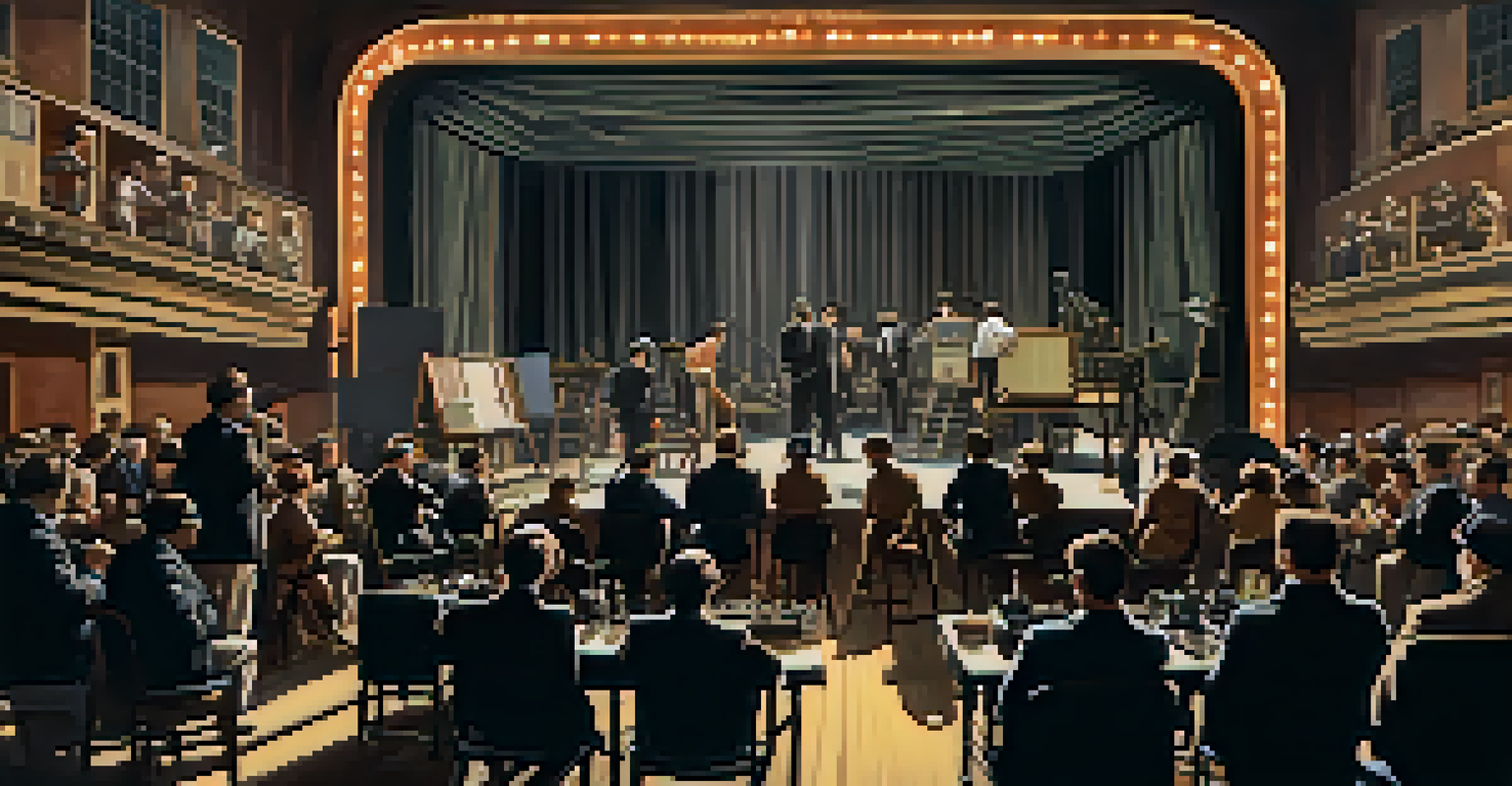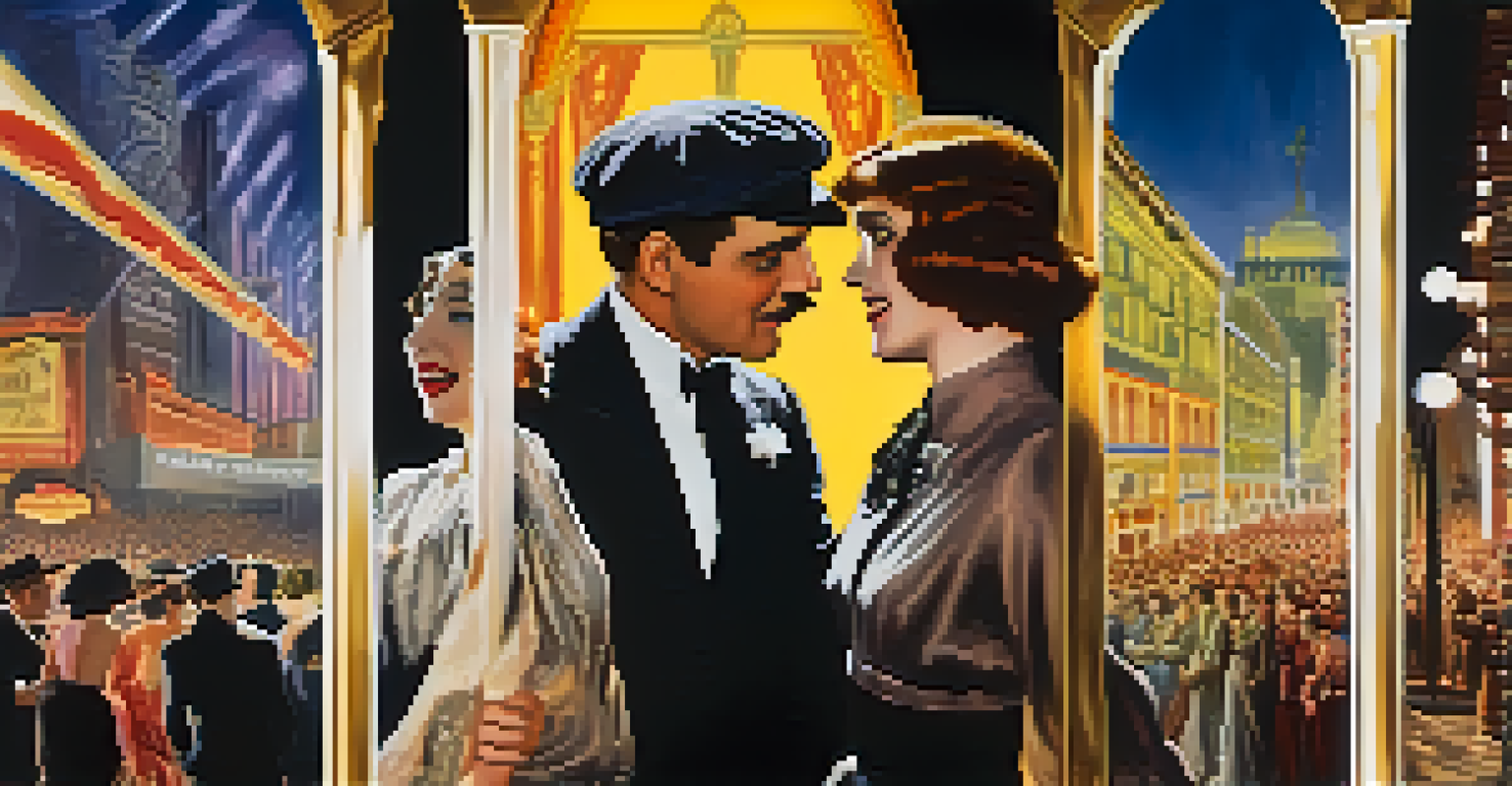Silent Films to Talkies: The Transformation of Theaters

The Birth of Silent Films: A New Era Begins
Silent films emerged in the late 19th century, captivating audiences with their visual storytelling. These early movies relied on expressive acting, intertitles, and live music to convey emotion and narrative. Imagine watching a film where the actors' exaggerated gestures tell a love story without a single spoken word; that was the magic of silent cinema. Theaters became vibrant spaces where people gathered, drawn by the novelty of moving images.
Film is a powerful medium that can change the world, and sound brought it to life in ways we never imagined.
As filmmakers experimented with techniques, the art of silent storytelling evolved, giving rise to iconic stars like Charlie Chaplin and Buster Keaton. Their unique styles not only entertained but also showcased the potential of film as a serious artistic medium. Audiences laughed, cried, and felt deeply, all without dialogue. This era set the foundation for what was to come, igniting a passion for cinema worldwide.
However, the silent film era was not without its challenges. The limitations of expressing sound made certain genres, like musicals, nearly impossible. As audiences craved more immersive experiences, the stage was set for a revolutionary shift that would transform the landscape of cinema forever.
The Advent of Sound: The Birth of Talkies
The introduction of synchronized sound in films marked a pivotal moment in cinematic history. The 1927 release of 'The Jazz Singer' is often credited with ushering in the era of talkies, captivating audiences with its innovative use of dialogue and music. Imagine the thrill of hearing voices on screen for the first time; it was a game changer! This breakthrough not only enhanced storytelling but also redefined the way actors performed.

With sound came new opportunities for genres to flourish. Musicals, comedies, and dramas took on a whole new life, as dialogue added depth to characters and narratives. Filmmakers quickly realized that sound could evoke emotions in ways visuals alone could not. Audiences became enamored with the combination of sight and sound, making the transition to talkies an undeniable success.
Silent Films: The Art of Expression
Silent films relied on visual storytelling, expressive acting, and live music to convey emotions and narratives without dialogue.
However, this transition wasn't seamless. Many silent film stars struggled to adapt to the new format, and some audiences were initially resistant to change. Yet, as studios embraced the innovation, the potential of sound in film quickly became apparent, paving the way for a new era of storytelling.
The Impact of Talkies on Film Production
The transition from silent films to talkies significantly impacted how movies were produced. Filmmakers had to rethink their techniques, incorporating sound design, dialogue writing, and music composition into their creative processes. This shift required new skills and technologies, leading to the emergence of sound studios and specialized personnel. The landscape of filmmaking evolved, making it more complex yet richer.
The magic of cinema is that it can speak to us without words, yet with sound, it can sing to our souls.
Cinematography also changed as filmmakers adjusted to the technical requirements of sound. Camera placements and lighting techniques had to be reimagined to accommodate microphones and the new demands of sound recording. This reconfiguration ultimately led to more innovative and dynamic storytelling, as directors could use sound to enhance visual elements.
Moreover, the success of talkies opened doors for new talents in the industry. Screenwriters, sound engineers, and composers became essential players in the filmmaking process. This collaborative approach enriched the cinematic experience, showcasing the power of teamwork in bringing stories to life.
Audience Reactions: Embracing the New Normal
Audience reactions to the advent of talkies were a mix of excitement and skepticism. Many moviegoers were thrilled to experience dialogue and music, while others missed the charm of silent films. The transition period was filled with debates about the merits of sound in cinema, with some claiming it distracted from the visual artistry. Yet, as more sound films were released, the allure of talkies became undeniable.
The societal impact of talkies was profound, reflecting the changing cultural landscape of the time. Films began to tackle more complex themes and narratives, resonating with audiences in ways that silent films could not. This shift allowed filmmakers to address social issues and human experiences more directly, making cinema a powerful medium for storytelling.
Talkies Revolutionize Cinema
The introduction of synchronized sound in films transformed storytelling, enhancing character depth and enabling new genres to flourish.
Over time, audiences fully embraced the new normal, leading to a decline in silent films. The excitement around talkies reshaped not only how movies were made but also how they were perceived. The collective experience of watching a film transformed, as audiences now shared laughter, tears, and thrills through the power of sound.
Technological Innovations: The Sound of Progress
The rise of talkies was propelled by significant technological innovations that changed the filmmaking landscape. Advances in sound recording equipment and techniques allowed filmmakers to capture high-quality audio on set. The introduction of the Vitaphone system, which synchronized sound with film, was revolutionary, enabling a seamless blend of dialogue and music. These innovations laid the groundwork for the sophisticated soundscapes we enjoy in cinema today.
As technology progressed, so did the complexity of sound in films. The development of multi-track recording allowed for more intricate sound design, enabling layers of dialogue, sound effects, and music to be combined seamlessly. This evolution meant that filmmakers could create richer auditory experiences that complemented the visual storytelling, enhancing audience engagement.
Moreover, innovations continued to shape the industry, influencing how films were distributed and experienced. The introduction of sound also marked the beginning of new genres and styles, including animated films, which leveraged sound to bring characters to life. This technological evolution not only transformed filmmaking but also redefined audience expectations for cinematic experiences.
Cultural Shifts: Reflecting Society Through Film
With the emergence of talkies, films began to reflect the cultural shifts and societal changes of the time. The ability to incorporate dialogue allowed filmmakers to address pressing issues, from the Great Depression to the rise of social movements. Movies became a mirror of society, exploring themes of identity, class struggle, and human experience in ways that resonated deeply with audiences.
As sound enriched storytelling, filmmakers began to push boundaries, experimenting with genres and styles. The musical genre flourished, captivating audiences with vibrant performances and catchy tunes. This not only entertained but also provided an escape during difficult times, solidifying the role of cinema as a cultural touchstone.
Cultural Reflection Through Film
Talkies allowed filmmakers to address societal issues and cultural shifts, making cinema a powerful medium for exploring complex themes.
Additionally, the influence of sound on film opened up new avenues for representation. Diverse voices and stories began to emerge, enriching the cinematic landscape and contributing to a broader understanding of different cultures. This ongoing dialogue between film and society continues to shape the world of cinema today.
The Legacy of Silent Films and Talkies
The legacy of silent films and the transition to talkies has left an indelible mark on the film industry. Silent films laid the groundwork for visual storytelling, showcasing the power of expression and artistry. Meanwhile, the advent of talkies revolutionized cinema, enhancing the emotional depth of narratives through sound. Together, these eras represent a significant evolution in how stories are told on screen.
Today, we can see the influence of both silent and sound films in contemporary cinema. Filmmakers continue to draw inspiration from the visual creativity of early silent films while utilizing modern sound technology to elevate their stories. This blend of techniques allows for innovative storytelling that resonates with diverse audiences worldwide.

Ultimately, the transformation of theaters from silent films to talkies represents a remarkable journey of artistic growth and technological advancement. As we celebrate this evolution, we honor the filmmakers, actors, and audiences who shaped the cinematic landscape, leaving a legacy that continues to inspire future generations.